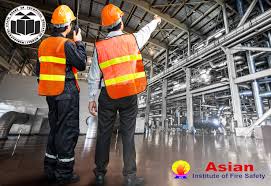
DIPLOMA IN FIRE ENGINEERING AND INDUSTRIAL SAFETY MANAGEMENT (2 YEAR)
🎓 DIPLOMA IN FIRE ENGINEERING AND INDUSTRIAL SAFETY MANAGEMENT
📚 COURSE STRUCTURE
📘 YEAR 1: FOUNDATIONS IN FIRE ENGINEERING & SAFETY MANAGEMENT
1. History of Fire Engineering and Safety
- Evolution of fire fighting: ancient to modern era
- Development of organized fire services
- Key historical fire disasters (Great Fire of London, Bhopal Gas Tragedy, etc.)
- Evolution of industrial safety: from early factories to modern regulations
- Growth of fire and safety standards (NFPA, OSHA, NBC)
2. Fire Science and Technology
- Fire chemistry and physics
- Classification of fire (A, B, C, D, K)
- Heat transfer and fire spread
- Stages of fire development
3. Fire Protection and Control Systems
- Fire extinguishers: types, operation, maintenance
- Fire detection and alarm systems
- Sprinkler systems and hydrants
- Gas-based suppression systems (CO₂, FM-200, etc.)
4. Fundamentals of Industrial Safety
- Introduction to workplace hazards
- Accident causation and prevention theories
- Basic safety procedures in industries
- Hazard identification and risk assessment (HIRA)
5. First Aid and Emergency Response
- Principles of first aid
- CPR and rescue breathing
- Burn and fracture treatment
- Emergency evacuation and crowd control
6. Personal Protective Equipment (PPE)
- Types of PPE for various hazards
- Safety helmets, harnesses, gloves, respiratory gear
- Proper use and maintenance
- Safety signs and symbols
7. Fire Drills and Practical Training
- Live fire extinguisher use
- Hose handling and hydrant operation
- Rescue simulations
- Site visits (fire station or factory)
📙 YEAR 2: ADVANCED FIRE ENGINEERING & INDUSTRIAL RISK MANAGEMENT
1. Advanced Fire Engineering
- Fire-resistant construction
- Fire load and fire risk calculation
- Compartmentation and smoke control
- Design and layout for fire safety
2. Electrical and Mechanical Safety
- Electrical fire hazards and safe practices
- Static electricity, short circuits, and overloads
- Mechanical equipment guarding
- Preventive maintenance for fire safety
3. Occupational Health and Safety (OHS)
- Workplace ergonomics
- Industrial hygiene and exposure control
- Noise, dust, vibration, and chemical safety
- ISO 45001 / OHSAS 18001 overview
4. Safety Legislation and Standards
- The Factories Act, 1948
- Explosives Act, Petroleum Act
- OSHA (basic overview), National Building Code (NBC – Fire provisions)
- Environmental and safety compliance
5. Disaster and Emergency Management
- Types of disasters (natural and man-made)
- Disaster risk reduction and mitigation
- Emergency Operation Centre (EOC) planning
- Role of fire services and safety officers in disaster management
6. Industrial Safety Audit & Inspection
- Safety audit process and tools
- Workplace inspection checklist
- Root cause analysis (RCA)
- Incident/accident investigation and reporting
7. Project Work / Internship
- Field training in industry or fire department (minimum 30–60 days)
- Preparation of project report based on real-world safety observation or drill
- Presentation and viva

